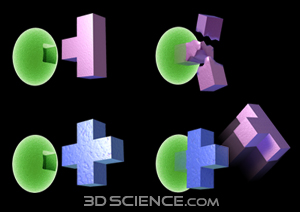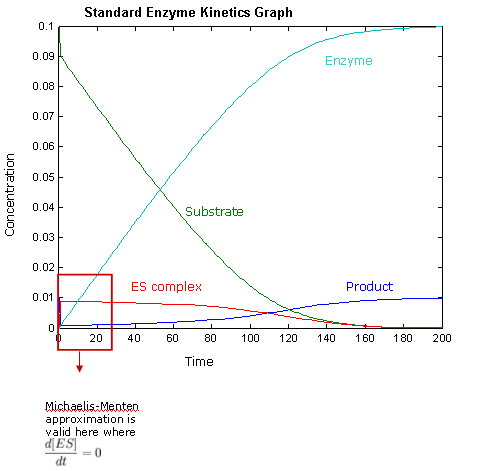Team:Imperial College London/Drylab/Enzyme
From 2009.igem.org
(→The System) |
(→The System) |
||
| (23 intermediate revisions not shown) | |||
| Line 3: | Line 3: | ||
<font face='Calibri' size='5'><b>Kinetics of drug protein of interest</b></font> | <font face='Calibri' size='5'><b>Kinetics of drug protein of interest</b></font> | ||
| + | <br> | ||
| - | Both our proteins of interest, PAH and cellulase, are enzymes to be released in the small intestines, after degradation of the capsule. As part of the study for our system, we would like to calculate the amount of enzyme a capsule must contain so that a PAH-replacement therapy or a grass-based diet becomes a feasible prospect. | + | Both our proteins of interest, [[Team:Imperial_College_London/PAH | PAH]] and [[Team:Imperial_College_London/M1/Cellulase | cellulase]], are enzymes to be released in the small intestines, after degradation of the capsule. As part of the study for our system, we would like to calculate the amount of enzyme a capsule must contain so that a PAH-replacement therapy or a grass-based diet becomes a feasible prospect. |
A necessary step for this calculation is the estimation of the enzymatic activity of our enzymes of interest. | A necessary step for this calculation is the estimation of the enzymatic activity of our enzymes of interest. | ||
The standard model for enzymatic action will be used to analyse the raw data (either the substrate concentration or the product concentration over time) gathered in the wetlab. | The standard model for enzymatic action will be used to analyse the raw data (either the substrate concentration or the product concentration over time) gathered in the wetlab. | ||
| + | |||
| + | [[Image:ii09_pro-lawn-logo9.jpg | 100px]] | ||
| + | |||
| + | [[Image:ii09_ek1.jpg | right | 200px]] | ||
| + | |||
===Our Goals=== | ===Our Goals=== | ||
| Line 16: | Line 22: | ||
**Assess how its various parameters can affect its output. | **Assess how its various parameters can affect its output. | ||
**Investigate the validity of the common Michaelis-Menten assumption of enzyme kinetics. | **Investigate the validity of the common Michaelis-Menten assumption of enzyme kinetics. | ||
| + | |||
| + | |||
| + | <html><a href="https://2009.igem.org/Team:Imperial_College_London/Drylab/Enzyme/Analysis/Detailed#Equation_4-MM:_New_rate_of_change_of_product"><img style="vertical-align:bottom;" width=50px align="left" src="http://i691.photobucket.com/albums/vv271/dk806/II09_Learnmore.png"></a></html> about the Michaelis-Menten assumptions! | ||
| Line 23: | Line 32: | ||
| - | <html><a href="https://2009.igem.org/Team:Imperial_College_London/Drylab/Enzyme/Analysis"><img style="vertical-align:bottom;" width= | + | <html><a href="https://2009.igem.org/Team:Imperial_College_London/Drylab/Enzyme/Analysis"><img style="vertical-align:bottom;" width=50px align="left" src="http://i691.photobucket.com/albums/vv271/dk806/II09_Learnmore.png"></a></html> about the model assumptions and predictions! |
<br> | <br> | ||
| - | |||
===The System=== | ===The System=== | ||
| Line 32: | Line 40: | ||
The behaviour of the system (the single-substrate mechanism) can be described with four ordinary differential equations (ODEs). Each component is described by a simple rate term for each of the four species involved in the mechanism. | The behaviour of the system (the single-substrate mechanism) can be described with four ordinary differential equations (ODEs). Each component is described by a simple rate term for each of the four species involved in the mechanism. | ||
| - | <html><a href="https://2009.igem.org/Team:Imperial_College_London/Drylab/Enzyme/Analysis/Detailed"><img style="vertical-align:bottom;" width= | + | <html><a href="https://2009.igem.org/Team:Imperial_College_London/Drylab/Enzyme/Analysis/Detailed"><img style="vertical-align:bottom;" width=50px align="left" src="http://i691.photobucket.com/albums/vv271/dk806/II09_Learnmore.png"></a></html> about the equations and what they mean! |
<br> | <br> | ||
<br> | <br> | ||
| Line 38: | Line 46: | ||
===Summary of simulation results=== | ===Summary of simulation results=== | ||
| + | |||
| + | [[Image:ii09_enzymekinetics.png | right]] | ||
| + | |||
| + | *For lower values of [S<sub>0</sub>], the rate of formation of the product is directly proportional to the amount of [S0]. However, for higher values of [S<sub>0</sub>], rate of formation of product saturates at a maximum rate. | ||
| + | *Michaelis-Menten approximation only holds for very small values of [E<sub>0</sub>]. | ||
| + | *Increasing K<sub>3</sub> values will increase rate of formation of product. | ||
| + | |||
| + | |||
| + | <html><a href="https://2009.igem.org/Team:Imperial_College_London/Drylab/Enzyme/Simulations"><img style="vertical-align:bottom;" width=50px align="left" src="http://i691.photobucket.com/albums/vv271/dk806/II09_Learnmore.png"></a></html> about the simulations! <br><br><br> | ||
| + | |||
===Conclusions=== | ===Conclusions=== | ||
| + | |||
| + | *Michaelis-Menten assumption can be applied to our system because for us, K<sub>M</sub> >> [E<sub>0</sub>] | ||
| + | |||
===References=== | ===References=== | ||
| + | |||
| + | [1]Alon, U (2006) An Introduction to Systems Biology: Design Principles of Biological Circuits - Chapman & Hall/Crc Mathematical and Computational Biology<br> | ||
| + | [2]Physica A: Statistical and Theoretical Physics, Vol. 188, No. 1-3. (1 September 1992), pp. 404-425. A rigorous derivation of the chemical master Equation | ||
<!--The protein drug of interest is an enzyme. It will bind to specific substrates and increase the rate of their conversion into products. Therefore, by monitoring either the substrate concentration or the product concentration, we can indirectly see the activity of the enzyme. This is quantified by measuring by enzyme activity in the [https://2009.igem.org/Team:Imperial_College_London/Wetlab/Protocols/cellulase cellulase assay] and [https://2009.igem.org/Team:Imperial_College_London/Wetlab/Protocols/PAH PAH assay]. Enzyme activity is the rate of substrate utilisation /product formation per unit time. | <!--The protein drug of interest is an enzyme. It will bind to specific substrates and increase the rate of their conversion into products. Therefore, by monitoring either the substrate concentration or the product concentration, we can indirectly see the activity of the enzyme. This is quantified by measuring by enzyme activity in the [https://2009.igem.org/Team:Imperial_College_London/Wetlab/Protocols/cellulase cellulase assay] and [https://2009.igem.org/Team:Imperial_College_London/Wetlab/Protocols/PAH PAH assay]. Enzyme activity is the rate of substrate utilisation /product formation per unit time. | ||
| Line 52: | Line 76: | ||
This model will allow an understanding of the activity of the enzymes and allow the WETLAB to have an idea of the magnitude of the enzymatic activity. More importantly, after the results from enzyme assays are obtained, the model should provide a means of relating the activity output data to the concentration of the enzyme. --> | This model will allow an understanding of the activity of the enzymes and allow the WETLAB to have an idea of the magnitude of the enzymatic activity. More importantly, after the results from enzyme assays are obtained, the model should provide a means of relating the activity output data to the concentration of the enzyme. --> | ||
| + | |||
| + | <html><center><a href="https://2009.igem.org/Team:Imperial_College_London/Drylab/Autoinduction"><img style="vertical-align:bottom;" width="20%" src="http://i691.photobucket.com/albums/vv271/dk806/II09_Drylabmainimage1.png"></a><a href="https://2009.igem.org/Team:Imperial_College_London/Drylab/Protein_Production"><img style="vertical-align:bottom;" width="20%" src="http://i691.photobucket.com/albums/vv271/dk806/II09_Drylabmainimage2.png"></a><a href="https://2009.igem.org/Team:Imperial_College_London/Drylab/Enzyme"><img style="vertical-align:bottom;" width="20%" src="http://i691.photobucket.com/albums/vv271/dk806/II09_Drylabmainimage3.png"></a> | ||
| + | <a href="https://2009.igem.org/Team:Imperial_College_London/Drylab/Genome_deletion"><img style="vertical-align:bottom;" width="20%" src="http://i691.photobucket.com/albums/vv271/dk806/II09_Drylabmainimage5.png"></a></center></html> | ||
| + | |||
| + | <html><table border="0" style="background-color:transparent;" width="100%"> | ||
| + | <tr><td width="0%"> </td> | ||
| + | <td width="22%"><center><a href="https://2009.igem.org/Team:Imperial_College_London/Drylab/Autoinduction"><b>Autoinduction</b></a></center></td> | ||
| + | <td width="22%"><center><a href="https://2009.igem.org/Team:Imperial_College_London/Drylab/Protein_Production"><b>Protein Production</b></a></center></td> | ||
| + | <td width="22%"><left><a href="https://2009.igem.org/Team:Imperial_College_London/Drylab/Enzyme"><b>Drug Kinetics</b></a></left></td> | ||
| + | <td width="22%"><left><a href="https://2009.igem.org/Team:Imperial_College_London/Drylab/Genome_deletion"><b>Genome Deletion</b></a></left></td> | ||
| + | <td width="1%"></td> | ||
| + | </tr></table></html> | ||
| + | <br> | ||
{{Imperial/09/TemplateBottom}} | {{Imperial/09/TemplateBottom}} | ||
Latest revision as of 08:46, 14 October 2009

- Overview
- The model
- Simulations
Kinetics of drug protein of interest
Both our proteins of interest, PAH and cellulase, are enzymes to be released in the small intestines, after degradation of the capsule. As part of the study for our system, we would like to calculate the amount of enzyme a capsule must contain so that a PAH-replacement therapy or a grass-based diet becomes a feasible prospect.
A necessary step for this calculation is the estimation of the enzymatic activity of our enzymes of interest.
The standard model for enzymatic action will be used to analyse the raw data (either the substrate concentration or the product concentration over time) gathered in the wetlab.
Contents |
Our Goals
- Overview of system
- Characterise the general dynamics of the system, including its two main modus operandi.
- Assess how its various parameters can affect its output.
- Investigate the validity of the common Michaelis-Menten assumption of enzyme kinetics.
 about the Michaelis-Menten assumptions!
about the Michaelis-Menten assumptions!
- Data analysis
- Show how the relation between the enzymatic activity of our protein of interest and the rate of breakdown of substrate, d[P]/dt can be exploited.
- Investigate ways to estimate the concentrations of enzyme or substrate if either is unknown as is the case in our experiments.
 about the model assumptions and predictions!
about the model assumptions and predictions!
The System
The behaviour of the system (the single-substrate mechanism) can be described with four ordinary differential equations (ODEs). Each component is described by a simple rate term for each of the four species involved in the mechanism.
 about the equations and what they mean!
about the equations and what they mean!
Summary of simulation results
- For lower values of [S0], the rate of formation of the product is directly proportional to the amount of [S0]. However, for higher values of [S0], rate of formation of product saturates at a maximum rate.
- Michaelis-Menten approximation only holds for very small values of [E0].
- Increasing K3 values will increase rate of formation of product.
Conclusions
- Michaelis-Menten assumption can be applied to our system because for us, KM >> [E0]
References
[1]Alon, U (2006) An Introduction to Systems Biology: Design Principles of Biological Circuits - Chapman & Hall/Crc Mathematical and Computational Biology
[2]Physica A: Statistical and Theoretical Physics, Vol. 188, No. 1-3. (1 September 1992), pp. 404-425. A rigorous derivation of the chemical master Equation




 "
"





